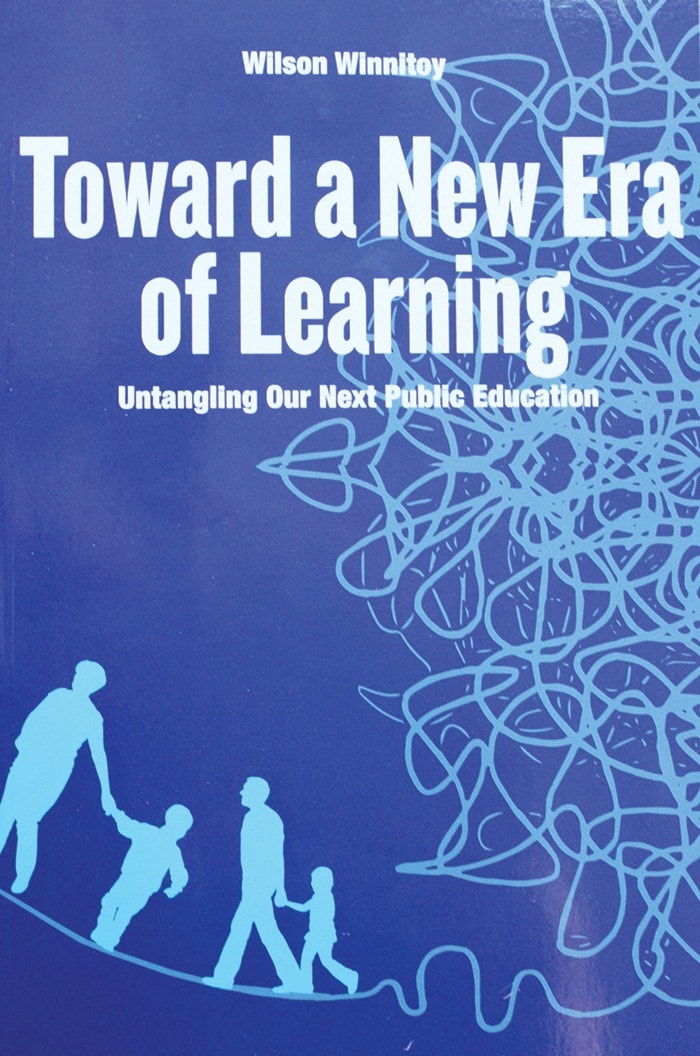Retired educator Wilson Winnitoy thinks we have to move Toward a New Era of Learning.
His newly released book, subtitled Untangling Our Next Public Education, makes a case for wholesale change from a system that no longer meets the needs of society to one that centers education in the home and community, freeing students from brick and mortar schools.
From the outset Winnitoy is careful to pay homage to the people who are trying to make public education work. They are doing their best to fix a system that first emerged during the 19th Century, meeting the needs of the Industrial Revolution.
You don’t have to look far to find well intentioned, hard working people trying to make that system work.
“It is visible in the creative efforts of many dedicated teachers and school administrators as they surmount, day by day, the dehumanizing tendencies of large-scale mass education,” Winnitoy says in his introduction.
Sympathetic and admiring as he is, he’s blunt about their chances of success. The system we now have can’t be fixed; focusing all our energy on trying to fix it is distracting us from the real task at hand, exploring and inventing something that matches the needs of the 21st Century.
The difference between ‘schooling’ and ‘learning’ lies at the heart of the challenge, Winnitoy says.
“Will learning remain a process of consumption of packaged and graded curricula and programs,” he asks, “or will it become a process of co-creation by and with the learner?”
The instinctive response to those kinds of ringing declarations is to try and put them back in the box. They challenge a system we are familiar with, and all have stories about; they also challenge us to take risks, tilting at an institution case hardened against fundamental change.
They are also often made by dilettantes and frustrated opponents of the system, who don’t really understand the complexities of the problems they are waving their magic wands at.
It’s interesting to note that the Alberta Teachers Association is among the list of copyright holders to Winnitoy’s book.
In the introductory pages Winnitoy is described as an ‘advisor and facilitator’ to a large urban school system, and as a consultant to the Alberta Teachers’ Association’s Strategic Planning Group for over two decades.
So when he talks about the ‘next education’ he’s coming from a place, where as he has lots of experience from perspectives that challenge the status quo.
What he envisions is ‘third schools’ – the ‘first schools’ being what emerged as an education system tailor made for the Industrial Revolution; the ‘second schools’ – which began taking shape during the 50s – being a system under stress, trying to adapt to and cope with societal change, and ultimately failing.
Third schools are not so much schools at all, as individualized learning programs worked out dynamically by the learner, at the centre, with family members, community and a ‘family teacher’ assigned by the school system.
Winnitoy creates a scenario to describe how this third school system might work in a typical family.
Almost predictably, this is where the analysis breaks down, a faltering that echoes the dilemma faced by anyone who wants to implement wholesale change to our public education system.
His description of ‘co-created learning’ will not be convincing even to many who want to see significant changes to the public education system we have inherited from the 19th Century – let alone to those who think there’s nothing wrong with a system that has some starch in it, and even some desks in straight rows.
That doesn’t take away from the value of his effort, and Winnitoy is well aware that his scenario can’t be considered a final blueprint.
“The purpose of this book is to make our contemporary into a new landscape of public education visible to us.
He has succeeded in that.
